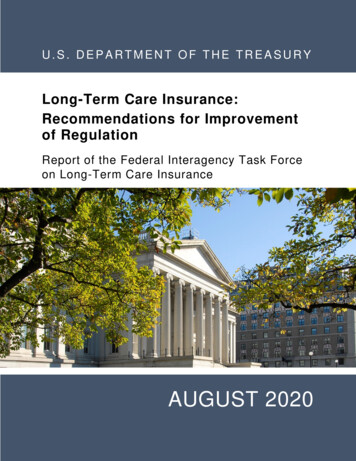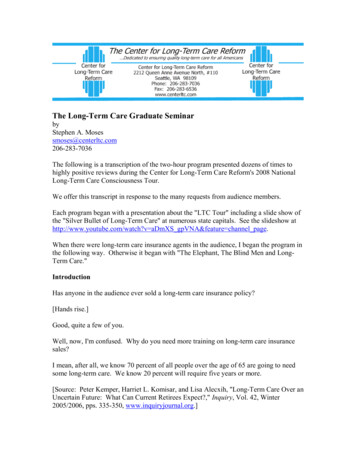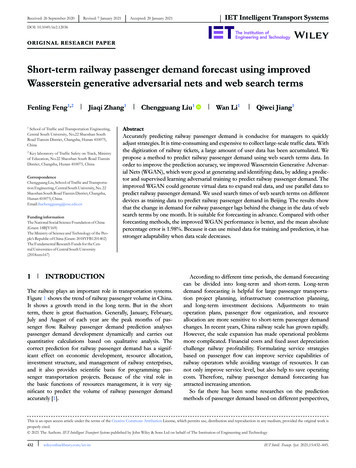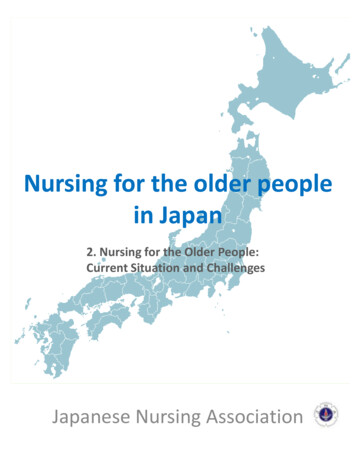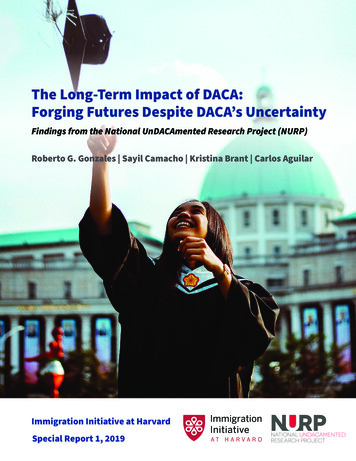
Transcription
The Long-Term Impact of DACA:Forging Futures Despite DACA’s UncertaintyFindings from the National UnDACAmented Research Project (NURP)Roberto G. Gonzales Sayil Camacho Kristina Brant Carlos AguilarImmigration Initiative at HarvardSpecial Report 1, 2019
Roberto G. Gonzales Sayil Camacho Kristina Brant Carlos AguilarAbout the AuthorsRoberto G. Gonzales, Ph.D. is professor of education at Harvard Graduate School of Education. Since 2002 he has carried out one of the most comprehensive studies of undocumentedimmigrant youth and young adults in the United States. He is also the author of Lives in Limbo:Undocumented and Coming of age in America and the Principal Investigator of the NationalUnDACAmented Research Project.Sayil Camacho (Ph.D., University of California, Los Angeles) is a Postdoctoral Fellow at thePeabody College of Education and Human Development and works on the Policies for ActionResearch Hub study funded by the Robert Wood Johnson Foundation. In this role, Camachoexamines how current policies, processes, and program structures might be adapted to moreeffectively serve the needs of families, particularly children of immigrants. Camacho is therecipient of the UCLA Equity, Diversity and Inclusion award and the 40 for 40 Fellowship Association for Public Policy Analysis & Management award.Kristina Brant is a PhD candidate in Sociology at Harvard University and a Doctoral Fellow inthe Multidisciplinary Program in Inequality and Social Policy at the Harvard Kennedy School.Her research focuses on the causes and consequences of persistent, concentrated poverty inrural communities.Carlos Aguilar is a doctoral student at Harvard Graduate School of Education. His current research centers on issues related to undocumented youth’s social and educational experiences.As an undocumented immigrant and DACA recipient, Carlos’ underlying emphasis is to complicate current narratives and theoretical frameworks surrounding undocumented immigrationby highlighting the complex experiences of individuals, families, and communities.AcknowledgementsThis study is made possible through the generous support of the John D. and Catherine T.MacArthur Foundation, the Bill & Melinda Gates Foundation, the James Irvine Foundation, andthe Heising-Simons Foundation.2The Long-Term Impact of DACA: Forging Futures Despite DACA’s UncertaintyFindings from the National UnDACAmented Research Project (NURP)
Acknowledgments & ContentsContents4Executive Summary & Introduction9DACA as a Vehicle for Social MobilityNew Educational Pathways and OpportunitiesOpening Work and Career PathwaysSupporting Families and Strengthening CommunitiesImproved Health and Well-BeingOpening Access to Travel26The Experience of DACA Beneficiaries Varies According to State and Local PoliciesThe Impact of State and Local PoliciesAccess to Higher EducationAccess to Occupational LicensesNavigating Immigration Enforcement35Remaining Barriers to Social and Economic ProgressThe Limitations of DACA StatusOngoing Family VulnerabilityThe Threat of DACA Termination48ConclusionExpanding Access to Educational OpportunitiesBolstering Work and Career Pathways52Endnotes3The Long-Term Impact of DACA: Forging Futures Despite DACA’s UncertaintyFindings from the National UnDACAmented Research Project (NURP)
Roberto G. Gonzales Sayil Camacho Kristina Brant Carlos AguilarExecutive SummaryFor decades, undocumented youth who have grown up in the United States have enteredadulthood encountering steep barriers to educational, economic, and social opportunities.Due to congressional inactivity on immigration, these young people have been forced to puttheir lives on hold. This changed in June of 2012 with the introduction of the Deferred Action for Childhood Arrivals (DACA) program, an administrative policy which offers eligibleyoung people work authorization and temporary protection from deportation. Since 2012,more than 800,000 young people have received DACA status.In this report, we illustrate the profound impact DACA has had on beneficiaries, their families, and their communities over the last seven years. We draw on data from the NationalUnDACAmented Research Project (NURP)—a longitudinal, national study launched in 2013to understand how young people were experiencing their DACA status. Our respondents constitute a diverse sample of 408 DACA beneficiaries from six states, representing a vast arrayof racial, ethnic, economic, and educational backgrounds.Prior to DACA, our respondents faced numerous barriers that impeded life course trajectoriesand well-being, as well as prevented them from establishing their independence. Over thecourse of our study, we watched our DACAmented respondents harness numerous newfoundopportunities. For those who had previously left high school, DACA has provided motivation to enroll in GED and adult education programs. For those seeking higher education,DACA has improved access to vocational programs, community colleges, universities, andgraduate schools. Work authorization has enabled our respondents to obtain new jobs, access higher wages, and pursue meaningful and stable careers. Together, these educationaland economic opportunities have bolstered our respondents’ abilities to support theirfamilies and strengthen their communities. With broader inclusion in society, our respondents have experienced improved mental health and well-being.4The Long-Term Impact of DACA: Forging Futures Despite DACA’s UncertaintyFindings from the National UnDACAmented Research Project (NURP)
Executive Summary & IntroductionDespite this incredible progress, our respondents continue to face limitations due to the temporary and partial nature of DACA and the lack of protection for family members and lovedones. Ultimately, these barriers limit upward mobility and long-term well-being for our respondents and their families. Additionally, our respondents are subject to a mixed landscapeof state- and local-level policies; while those living in inclusive environments may experience improved access to social institutions, those living in restrictive contexts continue to bebarred from opportunities despite their DACA status.More importantly, our respondents are facing new anxieties and fears due to the uncertain future of the DACA program. In 2017, the Trump administration moved to terminate DACA. Asthis decision is being challenged in the courts, the United States Citizenship and ImmigrationServices (USCIS) has stopped accepting new applications; current DACA beneficiaries havebeen permitted to renew their status. The U.S. Supreme Court is expected to hear oral arguments on November 12, 2019. For our respondents, the potential DACA termination couldmean a reversal of the incredible progress made over the last seven years. Once again excluded from economic, educational, and social institutions, our respondents would be pushed outof jobs and educational programs, and they would face new financial hardships and significant psychological distress.5The Long-Term Impact of DACA: Forging Futures Despite DACA’s UncertaintyFindings from the National UnDACAmented Research Project (NURP)
Roberto G. Gonzales Sayil Camacho Kristina Brant Carlos AguilarIntroductionUntil recently, growing numbers of undocumented children and youth faced legal barriersto economic, educational, and social development.1 Despite their inclusion in K-12 schools,broader access to the country’s educational, economic, and social institutions was limited bytheir undocumented status. Annually, an estimated 98,000 undocumented students graduate from high schools while another 27,000 do not reach graduation.2 Due to congressionalinactivity on immigration, 125,000 students are forced to put their lives on hold every year.On June 15, 2012, this untenable position changed for many young people with the introduction of the Deferred Action for Childhood Arrivals (DACA) program, an administrativepolicy that offered eligible young people temporary protection from deportation along withwork authorization and other forms of legal access.3 In the program’s seven years, more than800,000 young people have become “DACAmented,” accessing previously unavailable lifeopportunities. DACA beneficiaries have acquired driver’s licenses, obtained employment thatbetter matches their career goals and educational attainment, and improved their financialcircumstances.4 Those who obtained DACA in their teenage years were able to gain access tothese benefits on time with their peers, smoothing their transitions to late adolescence andyoung adulthood.5 DACA beneficiaries are now in a better position to support their families.Many have improved their living arrangements, purchased new cars, and enrolled their children in day care programs. They have also experienced enhanced feelings of security, belonging, and overall well-being.6Shortly after DACA’s implementation, we established the National UnDACAmented ResearchProject (NURP)—a longitudinal, national study seeking to understand how DACA beneficiaries experience their new status. In 2013, we surveyed 2,684 DACA-eligible young adults.Then, in 2015, collaborating with community partners in six different states, we recruited adiverse group of 408 DACA beneficiaries from a vast array of racial, ethnic, economic, andeducational backgrounds. We have since carried out three waves of data collection with theserespondents.76The Long-Term Impact of DACA: Forging Futures Despite DACA’s UncertaintyFindings from the National UnDACAmented Research Project (NURP)
Executive Summary & IntroductionUpon receiving DACA, our respondents expressed renewed hope in their abilities to realizetheir future educational and career goals. Jin from California told us, “It gave me hope thatmy future is not up in the air anymore.” Ahmed from New York said that “I finally feel like Iam a part of the U.S., like I’m no longer living in the shadows.” And Jenny from Illinois explained, “In some ways, I feel like it saved my life.”Seven years into DACA and six and a half years into our study, much has changed for ourrespondents. A lack of legal status previously impeded many respondents’ abilities to pursuehigher education, find stable employment, and establish their independence. However, DACAhas opened a wide range of educational, economic, and social opportunities. Many of our respondents have completed postsecondary degrees and started careers. Access to employmentand driver’s licenses, for example, has improved respondents’ trajectories, and these gainshave been extended to their family members and loved ones, dramatically enhancing theiroverall quality of life. Our respondents have taken on more responsibilities and more peopledepend on them now.The tremendous improvement in our respondents’ trajectories demonstrates the powerfulimpact of DACA, arguably the most successful policy of immigrant integration in the lastthree decades. However, as an administrative policy, DACA has limited inclusionary power; itdoes not undo financial aid exclusions, and it does not offer a pathway to citizenship or otherforms of legal immigration status.On September 5, 2017, the Trump administration moved to terminate DACA. At the time ofthis writing, the future of the program is being challenged in the court system, and the U.S.Supreme Court is scheduled to hear oral arguments on November 12, 2019. While currentbeneficiaries may continue to apply for renewal, the United States Citizenship and Immigration Services (USCIS) is no longer accepting new applications. Hundreds of thousands ofyoung people turning 15 each year will not have the opportunity to benefit from DACA. Theuncertain future of the program has also put a damper on current DACA holders’ plans andhas generated new anxiety and fear. As of April 30, 2019, 669,080 young people were holdingDACA status.87The Long-Term Impact of DACA: Forging Futures Despite DACA’s UncertaintyFindings from the National UnDACAmented Research Project (NURP)
Roberto G. Gonzales Sayil Camacho Kristina Brant Carlos AguilarIn this report, we summarize the experiences of DACA beneficiaries who have gone throughseveral renewals but continue to worry about their futures in the United States. The narratives of our respondents shed important light on the positive impact of DACA, but also highlight its limitations in a time of uncertainty and heavy immigration enforcement. The resultsof this study have clear implications for U.S. immigration policy and practice.8The Long-Term Impact of DACA: Forging Futures Despite DACA’s UncertaintyFindings from the National UnDACAmented Research Project (NURP)
DACA as a Vehicle for Social MobilityDACA as a Vehicle for Social MobilityOver the course of our study, our respondents made significant strides in their personal andprofessional lives. When we first met, our respondents were harnessing newfound opportunities to work, drive, establish credit, access health insurance, and enroll in postsecondaryprograms. In our 2013 survey, large shares of our 2,684 respondents had obtained a new jobwithin their first year of having DACA status and many had increased their earnings. Earlierthis year, another national survey of 1,105 DACA beneficiaries found that 91 percent of respondents 25 or older were employed.9By our final interviews, these initial opportunities had translated to upward mobility in respondents’ work, school, and personal lives, as DACA incentivized onramps to educationalpathways and boosted employment options. GED enrollment and college matriculations materialized into hard-earned degrees and first jobs led to budding professional careers. Growing financial stability and a sense of security improved respondents’ health and well-beingand produced profound domino effects for families and communities. In the course of sevenyears, improved economic stability has enabled our respondents to take on new financialobligations—living independently, taking care of their families, enrolling their children indaycare programs, and managing car payments and mortgages.New Educational Pathways and OpportunitiesWhile DACA does not override exclusion from federal financial aid, it has, nevertheless, enabled beneficiaries to access new educational opportunities. Due to their ability to securestable employment and earn higher wages, DACA beneficiaries now have greater financialresources to afford higher education. Additionally, many states have extended state-basedbenefits, like in-state tuition, to DACA beneficiaries, making college more financially feasible.10 Work authorization has also increased DACA beneficiaries’ desires to pursue highereducation. By establishing a link between educational investments and tangible employmentopportunities, DACA has incentivized educational pursuits. While our respondents have long9The Long-Term Impact of DACA: Forging Futures Despite DACA’s UncertaintyFindings from the National UnDACAmented Research Project (NURP)
Roberto G. Gonzales Sayil Camacho Kristina Brant Carlos Aguilarrecognized the intrinsic value of education, many were discouraged that they could not utilizetheir degrees in relevant careers upon graduation. Work authorization ensures that educational investments will pay off.Over the course of our study, our respondents turned educational aspirations into tangible career outcomes. DACA facilitated the completion of vocational programs, associate’s degrees,bachelor’s degrees, and even graduate and professional degrees from master’s programs tolaw and medical school. Respondents then acquired jobs in related fields. Many used theseinitial employment opportunities as stepping-stones to launch new careers.Our interviews offer an important window into how these processes unfolded for our respondents. Take Laura, a DACA beneficiary from Arizona. When Laura was seventeen, her fatherlost his job, and her parents returned to Mexico. Everyday life became a struggle and Laurabarely finished high school. Facing the emotional and financial hardships of being separatedfrom her family, Laura put off going to college. Two years later, after learning about DACA,she pulled together the money she had saved from babysitting and cleaning houses for theapplication fee. It was not long before she received approval and, with it, a new lease onlife. Empowered by her newfound ability to pursue lawful employment, Laura enrolled in an8-month medical assistant training program. While not her preferred pathway to a careerin nursing, the medical assistant program was a more affordable and immediate option tojumpstart a career in medicine.It’s a step in the medical field. I can actually work with patients. I can get experience and[an] idea what it’s going to be like. I love the fact that I can actually work with people andhelp them in some way.Upon graduation from the program, Laura secured a stable job as a medical assistant. Notonly was this position in her field of interest, but it provided her a steady income from whichto save money. She plans to soon enroll in a degree program in nursing, likely at the associate’s level, and then to work her way up to a bachelor’s degree.10The Long-Term Impact of DACA: Forging Futures Despite DACA’s UncertaintyFindings from the National UnDACAmented Research Project (NURP)
DACA as a Vehicle for Social MobilityLaura’s story highlights how our respondents have utilized educational opportunities tojump-start new careers. Without access to financial aid, many DACA beneficiaries like Lauraare still economically restricted from pursuing their preferred postsecondary pathway. Because licensed programs are shorter and more affordable options, they provide DACA beneficiaries with entry points to a wide range of professions. Participating in these non-residentialprograms has also allowed them to live at home and to save money for tuition that wouldotherwise go towards independent living expenses. Many DACA beneficiaries have utilizedthese programs as stepping-stones to four-year degrees, making incremental career moves.Others have pursued them as gateways to specialized careers in growing industries. Workauthorization has provided DACA beneficiaries the assurance that they will be competitive inthese industries after completion of relevant training programs.For respondents completing certificate or licensing programs, 68 percent immediately sawhourly increases from 5-8 an hour to more than 14 an hour and 76 percent at least doubledtheir yearly salaries. Over time, our respondents have gained experience in these fields, allowing them to move up the occupational ladder.For many of our respondents, DACA facilitated even greater mobility through enrollmentin four-year colleges and universities. In our 2013 survey we found that four-year collegestudents were more likely to obtain new jobs, increase their earnings, and obtain paid internships in their chosen fields; across all respondents, the likelihood of obtaining new jobs andincreasing earnings was greatest among college graduates.Take Gabriel from New York City, who was able to enroll in a local college prior to DACAthanks to a private scholarship. When he received DACA in his junior year, Gabriel was ableto make the most of his newfound access. With aspirations to become a doctor, he was able topair his biology major with paid positions in the science and health fields to build his resumefor medical school. What’s more, DACA allowed Gabriel to envision medical school as a reality—access to work authorization could make it all possible, enabling him to secure a residencyposition and eventually a medical career.11The Long-Term Impact of DACA: Forging Futures Despite DACA’s UncertaintyFindings from the National UnDACAmented Research Project (NURP)
Roberto G. Gonzales Sayil Camacho Kristina Brant Carlos AguilarIn 2015, Gabriel explained to us the impact of DACA on his future plans.It’s opened up more doors and opportunities. Like now when I apply to medical school, because I have DACA I have a Social Security [number]. Medical schools are willing to considerme because then I can do residency and all that stuff.During the course of our study, Gabriel graduated from college, took the MCAT, and enrolledin medical school. At the time of our final interview in 2019, he was in his third year of medical school, studying to become a doctor of internal medicine and hoping to one day providehealthcare to under-resourced communities.As these stories demonstrate, DACA enabled our respondents to pursue their academic goalsand complete postsecondary degrees. For many like Laura, work authorization provided themeans and incentive to seek vocational training. This strategy launched careers in growingfields. For others like Gabriel, who had managed to access postsecondary education prior toDACA, early opportunities and investments paired with the ability to seek lawful employmentprovided a significant leg up in accessing career opportunities. While the inability to receivefederal financial aid continues to disadvantage respondents, DACA has nevertheless openednew opportunities to pursue higher education and jumpstart careers.Opening Work and Career PathwaysSince receiving DACA, beneficiaries have become increasingly integrated into our nation’sworkforce and economy. Work authorization has served as an entry point towards realizingcareer aspirations, as well as a basis of financial support for beneficiaries and their families.Work authorization has enabled DACA beneficiaries to acquire jobs in the formal labor market, access newfound workplace agency, and achieve upward mobility.Prior to DACA, our respondents were pressed to navigate the informal job market and oftenforced to accept substandard work conditions. With DACA, they have achieved notable socialmobility, and as a result, they have experienced increased job satisfaction and decreasedworkplace vulnerabilities. Key to their success, many of our respondents had multiple men-12The Long-Term Impact of DACA: Forging Futures Despite DACA’s UncertaintyFindings from the National UnDACAmented Research Project (NURP)
DACA as a Vehicle for Social Mobilitytors in high school, were active in extracurricular clubs, held leadership roles in their schools,were involved in their communities, and were connected to organizations. As a result, theypossessed the social networks and information necessary to access job-related opportunities.To illustrate the work and career implications of DACA, we showcase two notable pathways,highlighting the diverse ways DACA has positively impacted employment experiences forboth younger and older beneficiaries.Many of our respondents received DACA in their teenage years, so they were able to accesswork authorization and driver’s licenses at the same time as their American-born and citizenpeers. This early access allowed them to make important life course and educational transitions unencumbered by their undocumented status. Take Amir, a DACA beneficiary fromNew York. Both of his parents held advanced degrees from their native Pakistan. But theirundocumented status limited their ability to pursue employment in New York. Amir receivedDACA while in high school, giving him hope that he could harness employment opportunitiesthat were out of reach for his parents. He excelled in his information technology courses inhigh school, and as a result, his teacher helped him obtain an after-school job as a computer technician, serving various schools in a local school district. In addition to his work permit, DACA enabled him to obtain a driver’s license, which he needed to travel to the variousschools.Being able to drive is very, very important. It helps speed up the day. Not just that, for myjob I need to drive almost all day. Without having a driver’s license, I would not be able tohave the current job I do now.Over the next few years, Amir received several wage increases, and he completed additionalcertificate programs—making as much as 15 an hour. Amir’s stable wages allowed him tosave enough money to enroll in a computer science program at a local university. When wetalked to Amir in 2019, he was in the final semester of his bachelor’s program and had secureda full-time management position at an IT support desk for an international company. In thisposition he leads a global team of IT workers to improve security and company performance.Not only is Amir utilizing his technology skills, but he is also now a leader in his department,13The Long-Term Impact of DACA: Forging Futures Despite DACA’s UncertaintyFindings from the National UnDACAmented Research Project (NURP)
Roberto G. Gonzales Sayil Camacho Kristina Brant Carlos Aguilarmaking 30 an hour. Obtaining DACA at a young age enabled him to gain early experiencein a field that matched his interests and then to pursue an education that strengthened hisskillset, making him an even more competitive job candidate.For DACA beneficiaries who were older at the time of their initial DACA approval, early experiences navigating education and employment were much more difficult. With uncertainfutures and limited prospects for employment, these years were a struggle for many of ourolder respondents. However, DACA provided access to never-before held opportunities foremployment and postsecondary education.Oscar, a DACA beneficiary from California, was twenty-four years old when he received hisDACA status. Prior to DACA, Oscar financed his education by working in California’s agriculture industry, alongside his undocumented parents. Working in the fields exposed him tosignificant occupational health hazards and additional vulnerabilities because his employerknew he was undocumented. It took him six years to finish his undergraduate education.Ultimately, his hard work paid off in the form of academic success and acceptance into lawschool. Nevertheless, jobs in his field remained inaccessible, and he worried about the feasibility of pursing a legal career.Oscar received DACA during his first year of law school. As a result, he was able to pursuea paid legal internship that summer, keeping pace with his peers. During the course of ourstudy, Oscar finished his law degree, and he is now working at an immigration law firm thatserves under-resourced populations in his hometown in California’s Central Valley. Oscarcredits DACA for his major life accomplishments—a juris doctorate, home ownership, andhis law career. He told us that DACA had allowed him substantial professional growth. Oscarexemplifies the possibilities that arise when DACA beneficiaries are given opportunities torealize their professional ambitions.In the workforce, our respondents experienced newfound access to more stable jobs withhigher pay, better benefits, and less stressful working conditions. Over time, access to betterpaying jobs and new opportunities served as important stepping-stones to career trajectories.14The Long-Term Impact of DACA: Forging Futures Despite DACA’s UncertaintyFindings from the National UnDACAmented Research Project (NURP)
DACA as a Vehicle for Social MobilitySupporting Families and Strengthening CommunitiesAs discussed above, DACA has provided beneficiaries with improved access to the formal labor market, postsecondary education, and driver’s licenses. We find that these opportunitieshave not only improved beneficiaries’ quality of life but have also been extended to supportlarger units, such as their families. As a result, DACA has improved the quality of life for hundreds of thousands of mixed-status families living with a DACA beneficiary.Since obtaining DACA, most of our respondents have taken on additional familial responsibilities. Higher wages have enabled many respondents to offer more substantial financialcontributions to their households. With the legal ability to drive, many respondents now drivetheir undocumented family members to and from work and appointments. Access to state-issued identification has also permitted our respondents to act on behalf of their families inpurchasing cars and homes, signing leases, and acquiring financial services. And, since DACAhas facilitated access to informational networks, many respondents have helped their families access necessary services, from healthcare to organizational support. Taken together,these examples demonstrate how DACA has enabled beneficiaries to dramatically improvethe economic and psychological well-being of their families.Take Maria, a DACA beneficiary from New York City. Maria grew up in a mixed-status family—she and her mom were undocumented, and her younger siblings were U.S. citizens. As ateenager, Maria took on a significant share of household duties. She was tasked with the careof her younger siblings, getting them to and from school, and liaising with the school andother community institutions. Maria’s family experienced financial difficulty and housing insecurity, but without state-issued identification, it was often difficult to access support fromlocal social service organizations.Upon receiving DACA, Maria felt more secure in accessing services for her family and requesting resources they needed.15The Long-Term Impact of DACA: Forging Futures Despite DACA’s UncertaintyFindings from the National UnDACAmented Research Project (NURP)
Roberto G. Gonzales Sayil Camacho Kristina Brant Carlos AguilarBasically, I did not really have any other ID other than a school ID and that was very difficultfor my family because we would visit a lot of social services offices and they would not letme in. Nowadays when I have to go places with [my mother], it gives me a sense of, ‘Youcannot tell me I do not belong here anymore.’Thanks to DACA, Maria was also able to find a steady job, and put away money each month tohelp her mother secure a lease on a new apartment. With the help of supportive high schoolteachers, Maria secured scholarships to pay for college in full. By he
and well-being, as well as prevented them from establishing their independence. Over the course of our study, we watched our DACAmented respondents harness numerous newfound opportunities. For those who had previously left high school, DACA has provided motiva-tion to enroll in GED and adult education programs. For those seeking higher education,




